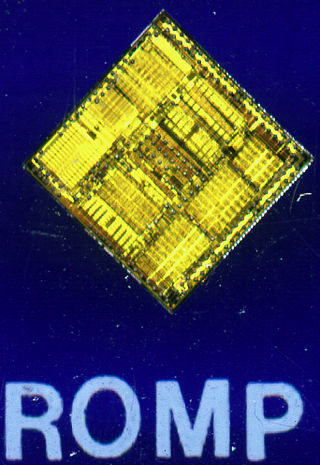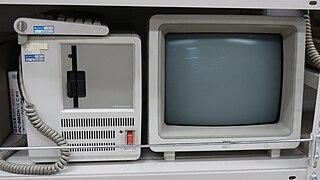
The 8086 is a 16-bit microprocessor chip designed by Intel between early 1976 and June 8, 1978, when it was released. The Intel 8088, released July 1, 1979, is a slightly modified chip with an external 8-bit data bus, and is notable as the processor used in the original IBM PC design.

A word processor is an electronic device for text, composing, editing, formatting, and printing.

DisplayWrite is a discontinued word processor program that IBM developed and marketed for the IBM PC and PCjr. It was among the company's first internally developed, commercially sold PC software titles.

Daisy wheel printing is an impact printing technology invented in 1970 by Andrew Gabor at Diablo Data Systems. It uses interchangeable pre-formed type elements, each with typically 96 glyphs, to generate high-quality output comparable to premium typewriters such as the IBM Selectric, but two to three times faster. Daisy wheel printing was used in electronic typewriters, word processors and computers from 1972. The daisy wheel is so named because of its resemblance to the daisy flower.

The Intel 8085 ("eighty-eighty-five") is an 8-bit microprocessor produced by Intel and introduced in March 1976. It is the last 8-bit microprocessor developed by Intel.

The Datapoint 2200 was a mass-produced programmable terminal usable as a computer, designed by Computer Terminal Corporation (CTC) founders Phil Ray and Gus Roche and announced by CTC in June 1970. It was initially presented by CTC as a versatile and cost-efficient terminal for connecting to a wide variety of mainframes by loading various terminal emulations from tape rather than being hardwired as most contemporary terminals, including their earlier Datapoint 3300.

The IBM System/3 was an IBM midrange computer introduced in 1969, and marketed until 1985. It was produced by IBM Rochester in Minnesota as a low-end business computer aimed at smaller organizations that still used IBM 1400 series computers or unit record equipment. The first member of what IBM refers to as their "midrange" line, it also introduced the RPG II programming language. It is the first ancestor in the product line whose current version is the IBM i series and includes the highly successful AS/400.

The IBM 3790 Communications System was one of the first distributed computing platforms. The 3790 was developed by IBM's Data Processing Division (DPD) and announced in 1974. It preceded the IBM 8100, announced in 1979.

The ROMP is a reduced instruction set computer (RISC) microprocessor designed by IBM in the late 1970s. It is also known as the Research OPD Miniprocessor and 032. The ROMP was originally developed for office equipment and small computers, intended as a follow-on to the mid-1970s IBM OPD Mini Processor microprocessor, which was used in the IBM Office System/6 word-processing system. The first examples became available in 1981, and it was first used commercially in the IBM RT PC announced in January 1986. For a time, the RT PC was planned to be a personal computer, with ROMP replacing the Intel 8088 found in the IBM Personal Computer. However, the RT PC was later repositioned as an engineering and scientific workstation computer. A later CMOS version of the ROMP was first used in the coprocessor board for the IBM 6152 Academic System introduced in 1988, and it later appeared in some models of the RT PC.
Pertec Computer Corporation (PCC), formerly Peripheral Equipment Corporation (PEC), was a computer company based in Chatsworth, California which originally designed and manufactured peripherals such as floppy drives, tape drives, instrumentation control and other hardware for computers.

The IBM 6580 Displaywriter System is a 16-bit microcomputer that was marketed and sold by IBM's Office Products Division primarily as a word processor. Announced on June 17, 1980 and effectively withdrawn from marketing on July 2, 1986, the system was sold with a 5 MHz Intel 8086, 128 KB to 448 KB of RAM, a swivel-mounted monochrome CRT monitor, a detached keyboard, a detached 8" floppy disk drive enclosure with one or two drives, and a detached daisy wheel printer, or Selectric typewriter printer. The primary operating system for the Displaywriter is IBM's internally developed word processing software titled "Textpack", but UCSD p-System, CP/M-86, and MS-DOS were also offered by IBM, Digital Research, and CompuSystems, respectively.

DECmate was the name of a series of PDP-8-compatible computers produced by the Digital Equipment Corporation in the late 1970s and early 1980s. All of the models used an Intersil 6100 or Harris 6120 microprocessor which emulated the 12-bit DEC PDP-8 CPU. They were text-only and used the OS/78 or OS/278 operating systems, which were extensions of OS/8 for the PDP-8. Aimed at the word processing market, they typically ran the WPS-8 word-processing program. Later models optionally had Intel 8080 or Z80 microprocessors which allowed them to run CP/M. The range was a development of the VT78 which was introduced in July 1977.

Diablo Data Systems was a division of Xerox created by the acquisition of Diablo Systems Inc. for US$29 million in 1972, a company that had been founded in 1969 by George E. Comstock, Charles L. Waggoner and others. The company was the first to release a daisy wheel printer, in 1970.

CPT Corporation was founded in 1971 by Dean Scheff in Minneapolis, Minnesota, with co-founders James Wienhold and Richard Eichhorn. CPT first designed, manufactured, and marketed the CPT 4200, a dual-cassette-tape machine that controlled a modified IBM Selectric typewriter to support text editing and word processing.

IBM 5550 is a personal computer series that IBM marketed in Japan, Korea, Taiwan and China in the 1980s and 1990s, for business use customers. In Japan, it was introduced in 1983 and promoted as "Multistation 5550 (マルチステーション5550)" because it had three roles in one machine: a PC, a word processing machine which was traditionally marketed as a machine different from a PC in Japan, and an IBM-host attached terminal.

The IBM Selectric was a highly successful line of electric typewriters introduced by IBM on 31 July 1961.

The IBM 6640 printer was one of the world's first office ink jet printers. It was originally announced as the 46/40 but later renamed as 6640, as part of the Office System/6 word processing range in 1976.
The IBM 5520Administrative System was a text, electronic document‐distribution and data processing system, announced by IBM General Systems Division (GSD) in 1979.
Omnidata Corporation was an American computer company active from 1978 to the late 1980s. The company was founded in Westlake Village, California, by Paul Van Alstyne in the aftermath of his company Wordplex being acquired by the Canada Development Corporation. Like Wordplex, Omnidata primarily focused on the design and manufacturing of word processing computer systems, whether they were sold by Omnidata themselves or provided to other companies to resell. In 1984, they released the Omni Convertible, a microcomputer system that supports up to three microprocessors, of differing architectures—including x86, m68k, Z80, and TMS9900—running simultaneously.















